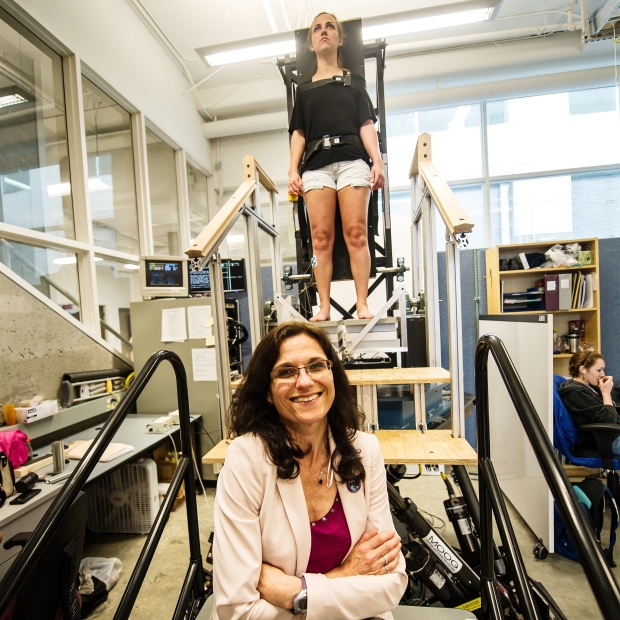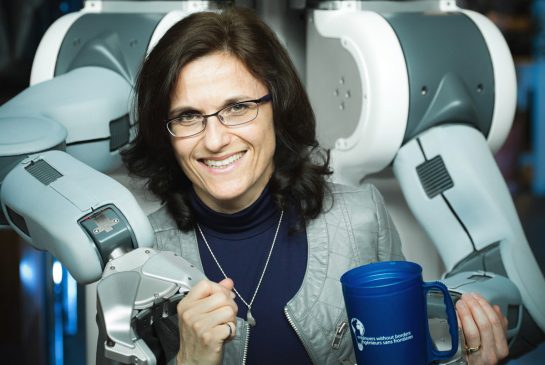
Elizabeth Croft
Associate Dean, Education and Professional Development, Faculty of Applied Science; Professor, Department of Mechanical Engineering; Director, Collaborative Advanced Robotics and Intelligent Systems Laboratory, University of British Columbia
Professor Croft's research investigates how robotic systems can operate efficiently and effectively in partnership with people
Media
Women in Engineering and Science (WISE) 2011
Women in Engineering and Science event 2011 Speaker: Dr. Elizabeth Croft
Robot kindergarten teaches droids of the future
Less than 100 years from now, robots will be friendly, useful participants in our homes and workplaces, predicts UBC mechanical engineering professor and robotics expert Elizabeth Croft. To read more, go to: http://goo.gl/KwCGLN
Elizabeth Croft, BASc’88 – Future of Robotics
The topic of ‘human-robot interaction’ will still be a hot one in 100 years. The tools may change but the problems, such as “How do people and robots get along?” will remain the same. Questions surrounding what robots should do; and how we can share, operate safely, communicate, take turns, teach robots, and generally get along together will continue to be problems requiring solutions. The efforts we make to establish the ‘rules of engagement’ now will certainly be foundational to our future relationships. Part of UBC100: What’s Next? A day of exploring the future Saturday, May 28th - UBC's Vancouver campus
A Robot in Every Home
By Rewild Films UBC engineering prof. Elizabeth Croft, BASc’88, is programming robots to interpret physical cues from humans.
alumni UBC100 What's Next? : Elizabeth Croft - Future of Robotics
Webcast sponsored by the Irving K. Barber Learning Centre. Great things happen when our brightest minds have the freedom to explore. When we pursue our unique interests, the resulting collective capacity for innovation is limitless. The issues of the future will require these creative solutions as the need to build connections between people, nations and disciplines has never been greater. The topic of ‘human-robot interaction’ will still be a hot one in 100 years. The tools may change but the problems, such as “How do people and robots get along?” will remain the same. Questions surrounding what robots should do; and how we can share, operate safely, communicate, take turns, teach robots, and generally get along together will continue to be problems requiring solutions. The efforts we make to establish the ‘rules of engagement’ now will certainly be foundational to our future relationships. Moderated by Marc Parlange – Dean and Professor, UBC’s Faculty of Applied Science
Transformation of vestibular signals for the control of standing in humans
Published by Journal of Neuroscience
2016 During standing balance, vestibular signals encode head movement and are transformed into coordinates that are relevant to maintaining upright posture of the whole body. This transformation must account for head-on-body orientation as well as the muscle actions generating the postural response. Here, we investigate whether this transformation is dependent upon a muscle's ability to stabilize the body along the direction of a vestibular disturbance. Subjects were braced on top of a robotic balance system that simulated the ...
Physical human–robot interaction
Published by Springer Handbook of Robotics
2016 Over the last two decades, the foundations for physical human–robot interaction (pHRI) have evolved from successful developments in mechatronics, control, and planning, leading toward safer lightweight robot designs and interaction control schemes that advance beyond the current capacities of existing high-payload and high-precision position-controlled industrial robots. Based on their ability to sense physical interaction, render compliant behavior along the robot structure, plan motions that respect human ...
URL: http://link.springer.com/chapter/10.1007/978-3-319-32552-1_69
Impacts of robot head gaze on robot-to-human handovers
Published by International Journal of Social Robotics
2015 In this paper, we investigate the use of a robot's gaze to improve the timing and subjective experience of face-to-face robot-to-human handovers. Based on observations of human gaze behaviors during face-to-face human–human handovers, we implement various gaze behaviors on a PR2 humanoid robot. We conducted two consecutive robot-to-human handover studies. Results show that when the robot continually gazes at a projected handover position while handing over an object, the human receivers reach for the object ...
URL: http://link.springer.com/article/10.1007/s12369-015-0305-z
Design and evaluation of a touch-centered calming interaction with a social robot
Published by IEEE Transactions on Affective Computing
2016 With advances in sensor and actuator design, intelligent computing techniques and personal care robotics, today's robots hold promise as fully interactive, therapeutic human companions. To achieve this ambitious goal, key interaction components must be identified and then systematically designed and evaluated. Based on successes of human-animal therapy, we propose affective touch as one such component. Delivering this adjunct in a controllable robot form allows us to examine its efficacy for therapeutic applications such ...
Active target search for high dimensional robotic systems
Published by Autonomous Robots
2017 When a robotic visual servoing/tracking system loses sight of the target, the servo fails due to loss of input. To resolve this problem a search method, namely a lost target search (LTS) which will generate efficient actions to bring the target back into the camera field of view (FoV) as soon as possible, is required. For high dimensional platforms, like a camera-mounted manipulator or an eye-in-hand system, such a search must address the difficult challenge of generating efficient actions in an online manner while avoiding ...
URL: http://link.springer.com/article/10.1007/s10514-015-9539-8
Biography
Elizabeth Croft is Associate Dean, Education and Professional Development for the Faculty of Applied Science, director of the Collaborative Advanced Robotics and Intelligent Systems Lab, and a registered Professional Engineer in the Province of British Columbia. Her research investigates how robotic systems can operate efficiently and effectively in partnership with people, in a safe, predictable, and helpful manner. She is the author of over 120 refereed publications in robotics, controls, visual serving, and human robot interaction. Applications of this work range from manufacturing assembly to healthcare and assistive technology, and her work has been funded by industry partners including Thermo-CRS, General Motors and Hyundai Heavy Industries. As Associate Dean for Education and Professional Development, Croft is responsible for undergraduate, graduate, and professional educational initiatives in Applied Science at both the Vancouver and Okanagan campus. She also led the development and successful launch of eight new professional programs in Engineering, Planning and Health in 2016. She provides oversight for the Engineering Cooperative Education program and Engineering Student Services. She also oversees communications, community outreach, marketing, and student recruitment. Croft served as NSERC Chair for Women in Science and Engineering, BC & Yukon (2010-2015) founding Westcoast Women in Engineering, Science, and Technology (WWEST) to attract, recruit, and retain women in engineering and science careers. Over her tenure as Chair, the percentage of women students entering first-year engineering at UBC increased from 20% to 30%. WWEST continues to work at national, regional, and local levels with organizations engaged in increasing the number of women in science, technology, engineering, and math (STEM) disciplines through multilateral partnerships spanning community, academic, and private sector partners. She also served as Principal Investigator for the National NSERC Chairs for Women in Science and Engineering Network and is PI for the Canadian Social Science and Humanities Research Council project “Engendering Engineering Success”, aimed at increasing the participation and retention of women in engineering careers.
Recognition/Reconnaissance
WXN Top 100 Most Powerful Women in Canada
2014
YWCA Women of Distinction Award,Education, Training & Development
2013
Wendy MacDonald Award, Diversity Champion, Vancouver Board of Trade
2016
NSERC Accelerator Award
2007
Just Desserts Award, UBC Alma Mater Society
2015
Canadian Council of Professional Engineers, Award for the Support of Women in Engineering
2006
Association of Professional Engineers and Geoscientists of British Columbia, Professional Service Award
2005




